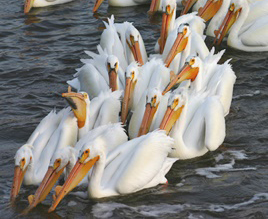Last Mountain Lake National Wildlife Area pamphlet

What makes Last Mountain Lake NWA so special?
Last Mountain Lake, Saskatchewan, has long been recognized for its value to migratory birds and wildlife. Situated at the heart of the central flyway of North America, Last Mountain Lake attracts hundreds of thousands of migrating birds each spring and fall. The north end of the lake was first protected in 1887 and is now a Migratory Bird Sanctuary (MBS). The National Wildlife Area (NWA), designated in 1987, surrounds and shelters the MBS. Together, the NWA and the MBS comprise close to 14 000 hectares of wetland and upland wildlife habitat.

Last Mountain Lake NWA:
- is part of the Western Hemisphere Shorebird Reserve Network;
- is recognized as a Ramsar Wetland of International Importance and an Important Bird Area;
- has played host to over 280 species of birds, of which 100 breed in the NWA;
- protects breeding habitat for colonial nesters such as American White Pelicans, Common Terns and Western Grebes;
- provides habitat for species at risk including Sprague’s Pipit, Piping Plover, Loggerhead Shrike and Baird’s Sparrow.
What are Environment and Climate Change Canada Protected Areas?

Environment and Climate Change Canada establishes marine and terrestrial NWAs for the purposes of conservation, research and interpretation. NWAs are established to protect migratory birds, species at risk, and other wildlife and their habitats. NWAs are established under the authority of the Canada Wildlife Act and are, first and foremost, places for wildlife.

Migratory Bird Sanctuaries (MBSs) are established under the authority of the Migratory Birds Convention Act, 1994, and provide a refuge for migratory birds in marine and terrestrial environments. The current Protected Areas Network consists of 54 NWAs and 92 MBSs comprising more than 12 million hectares across Canada.
What can I do at Last Mountain Lake NWA?
Public access to Last Mountain Lake NWA is permitted during daylight hours. Fishing, hunting, boating, canoeing, bird-watching, wildlife photography and nature study are authorized activities. Interpretive hiking trails, a floating boardwalk and a wildlife viewing tower are available for visitor use. Vehicles must stay on designated roads and trails. Special closures may occur whenever necessary over part or all of the NWA for purposes of conservation.

Long description of the map
Location of the NWA on an illustrated map of Canada. The NWA location is indicated by a general annotation in the province of Saskatchewan.
Who can I contact?
Environment and Climate Change Canada - Prairie and Northern RegionCanadian Wildlife Service
P.O. Box 280
Simpson, Saskatchewan S0G 4M0
1-800-668-6767
Email: ec.enviroinfo.ec@canada.ca
Protected Area web site
